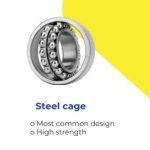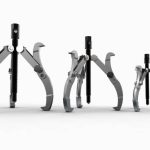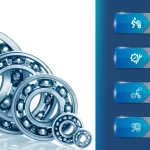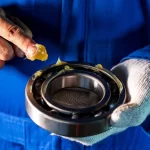In mechanical power transmission systems, bearings play a crucial role in supporting rotating components and facilitating the transfer of motion and power. Proper maintenance and alignment of bearings are paramount to ensure optimal performance and longevity of the system. Neglecting maintenance or misalignment can lead to premature failure, increased energy consumption, and costly downtime.
Significance of Bearings in Mechanical Power Transmission systems
- Motion Transmission: Bearings facilitate the transfer of rotational or linear motion from one component to another within a mechanical system. By providing low-friction surfaces for rotating or sliding elements, bearings allow shafts, gears, pulleys, and other transmission components to rotate smoothly and transmit motion effectively.
- Load Support: Bearings bear the weight and loads generated by moving components within a mechanical system. They distribute these loads evenly across their surfaces, preventing excessive stress and wear on individual components. This load-bearing capability is essential for ensuring the stability, reliability, and longevity of power transmission systems.
- Friction Reduction: Bearings minimize friction between moving parts, thereby reducing energy losses and improving the efficiency of power transmission systems. By incorporating rolling elements such as balls or rollers, bearings facilitate smooth, low-friction motion, which translates into enhanced energy efficiency and reduced power consumption.
- Alignment and Positioning: Bearings help maintain proper alignment and positioning of shafts, axles, and other transmission elements within a mechanical system. By supporting rotating components in precise locations, bearings ensure accurate assembly, alignment, and operation of power transmission equipment, minimizing wear, vibration, and noise.
- Vibration and Noise Reduction: Bearings dampen vibrations and absorb shocks generated during the operation of power transmission systems. By providing a cushioning effect between moving parts, bearings help reduce noise levels and enhance the overall comfort and safety of machinery operators and nearby personnel.
- Versatility and Adaptability: Bearings are available in various types, sizes, and configurations to suit diverse applications and operating conditions. From high-speed machinery to heavy-duty industrial equipment, bearings offer versatility and adaptability, allowing designers and engineers to customize power transmission systems according to specific requirements and performance criteria.
Proper Maintenance and Alignment Enhances Bearing Performance
Proper maintenance and alignment are essential for ensuring the reliable performance, efficiency, and safety of bearings in mechanical systems. By implementing proactive maintenance practices and ensuring precise alignment, businesses can maximize the value and longevity of their bearing assets. The following are the tangible outcomes:
- Optimal Operation: Proper maintenance ensures that bearings operate within their intended parameters, minimizing wear and tear and maximizing their lifespan. Regular lubrication, cleaning, and inspection help prevent issues such as overheating, corrosion, and premature failure, allowing bearings to function optimally.
- Reduced Downtime: Well-maintained bearings are less likely to experience unexpected failures or breakdowns, leading to reduced downtime in industrial processes. By proactively addressing potential issues through maintenance, businesses can avoid costly production interruptions and maintain continuous operation.
- Enhanced Efficiency: Properly aligned bearings experience reduced friction and wear, resulting in improved energy efficiency and reduced power consumption. When bearings are aligned correctly, they can transmit motion smoothly and efficiently, contributing to overall system performance and productivity.
- Extended Lifespan: Regular maintenance helps identify and address early signs of bearing wear or damage before they escalate into more severe problems. By addressing issues promptly, maintenance practices can extend the lifespan of bearings, delaying the need for costly replacements and minimizing overall operating expenses.
- Safety: Malfunctioning bearings pose safety risks to personnel and equipment. Improperly aligned or poorly maintained bearings can lead to unexpected failures, causing equipment damage, injuries, or even accidents in industrial settings. Proper maintenance and alignment practices help mitigate these risks, ensuring a safer working environment for employees.
- Cost Savings: Investing in regular maintenance and alignment practices ultimately leads to cost savings for businesses. By preventing costly repairs, replacements, and downtime associated with bearing failures, businesses can optimize their operational efficiency and minimize overall maintenance expenses over the long term.
Role of Bearings in Power Transmission Systems:
- Support: Bearings provide support for rotating or moving components such as shafts, gears, pulleys, and wheels, allowing them to rotate or move with minimal resistance.
- Load Distribution: Bearings distribute the weight and loads generated by rotating components evenly across their surfaces, preventing excessive stress and wear on individual parts.
- Friction Reduction: Bearings minimize friction between moving parts by incorporating rolling elements such as balls or rollers, thereby reducing energy losses and improving system efficiency.
- Alignment: Bearings help maintain proper alignment and positioning of shafts and other transmission elements, ensuring smooth operation and minimizing wear and vibration.
- Shock Absorption: Bearings absorb shocks and vibrations generated during operation, cushioning the impact and reducing noise levels in power transmission systems.
- Axial and Radial Support: Depending on the configuration, bearings can provide axial support (along the axis of rotation) and radial support (perpendicular to the axis of rotation) to accommodate different types of loads and motion.
Common types of bearings used include:
- Ball bearings
- Roller bearings
- Sleeve bearings
Each type offers specific advantages depending on application requirements, such as load capacity, speed, and operating conditions.
Common Maintenance Practices for Bearings
- Regular inspection: Periodic inspections help identify signs of wear, misalignment, or damage, allowing for timely corrective action.
- Lubrication: Proper lubrication ensures adequate lubricant film between bearing surfaces, reducing friction and minimizing wear.
- Cleaning: Removing contaminants helps prevent premature wear and ensures optimal bearing performance.
Common Techniques for Bearing Alignment
- Shaft alignment: Ensures correct positioning of shafts relative to each other, minimizing radial and axial loads on bearings.
- Coupling alignment: Ensures proper alignment between connected shafts, reducing stress and wear on bearings.
- Precision alignment tools: Dial indicators or laser alignment systems measure the relative position of shafts and couplings to ensure accurate alignment.
Techniques for Identifying Bearing Issues
- Vibration analysis: Detects abnormal vibration patterns associated with bearing wear or misalignment, enabling proactive maintenance.
- Temperature monitoring: Identifies overheating, which can indicate insufficient lubrication or excessive friction, allowing for timely intervention.
- Condition monitoring: Utilizes sensors and predictive maintenance techniques to monitor bearing health and detect potential issues before they escalate.
FAQ's
How do you check bearing alignment?
Bearing alignment can be checked using precision alignment tools such as dial indicators or laser alignment systems. These tools measure the relative position of shafts and couplings, ensuring accurate alignment. Proper alignment reduces stress on bearings and extends their lifespan, contributing to overall system reliability and performance.
What is the arrangement of bearings?
Bearings can be arranged in various configurations, including single-row, double-row, and angular contact arrangements. The arrangement depends on factors such as load capacity, speed, and application requirements.
What is bearing misalignment?
Bearing misalignment occurs when the axes of two connected shafts are not properly aligned. This misalignment leads to increased stress and wear on the bearings, reducing their lifespan and potentially causing premature failure. Proper alignment is essential to ensure smooth operation and prevent costly downtime.
What is the principle of self-aligning bearings?
Self-aligning bearings have a unique design feature that allows them to accommodate misalignment between shafts. This is achieved through a spherical outer raceway, which enables the bearing to adjust to shaft deflection or misalignment. Self-aligning bearings are commonly used in applications where shaft movement or misalignment is expected, providing enhanced performance and reliability.
What bearings are used in transmission?
Various types of bearings are used in transmission systems, including ball bearings, roller bearings, and tapered roller bearings. The choice of bearing depends on factors such as load capacity, speed, and operating conditions. Proper selection of bearings is critical to ensure efficient power transmission and reliable operation of the transmission system.
What is the function of bearings in a mechanical system?
Bearings play a critical role in mechanical systems by supporting rotating shafts, reducing friction between moving parts, and facilitating the transfer of motion and power. They ensure smooth operation, minimize energy losses, and increase system efficiency. Properly maintained bearings contribute to the overall reliability and performance of mechanical systems.



















